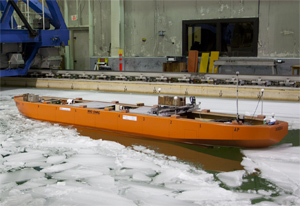Recap of the First Year of the National Shipbuilding Procurement Strategy
October 2012
 Testing of polar icebreaker scale model.
Testing of polar icebreaker scale model.It has been one year since the Government announced the result of its National Shipbuilding Procurement Strategy (NSPS), ushering in a $35-billion investment in the shipbuilding sector.
Over the past year, the Government has worked with industry to further lay the foundation for this procurement, which is expected to employ Canadians for more than 30 years in the designing and building of ships.
On August 20, 2012, the Government of Canada tested a scale model of its future polar icebreaker, the CCGS John G. Diefenbaker, in the world's longest ice tank. This unique testing facility is located at the National Research Council's Institute for Ocean Technology in St. John's, Newfoundland and Labrador.
This is one of the projects flowing from a historic moment on October 19, 2011. On that day, Irving Shipbuilding and Vancouver Shipyards were selected to rebuild our Canadian fleet. Not only two provinces but the entire Canadian shipbuilding sector was celebrating as government officials finally opened the envelope and put an exclamation mark to a selection process that brought with it $35 billion of investment, and the promises of eliminating the boom-and-bust cycle that had plagued the Canadian shipbuilding industry.
Congratulations on how the Government handled the NSPS selection process came from diverse sectors: industry and academia, as well as federal, provincial and local politicians praised how the Government selected the shipyards. The industry engagement, the use of independent third parties and a strong and active governance regime were all part of the success that the NSPS became.
According to Canada's Public Policy Forum, the National Shipbuilding Procurement Strategy was declared the 2011 top public policy story and “game-changer” of the year for improving how procurement processes are conceived and conducted. The NSPS also won other awards, such as the PWGSC Deputy Minister Special Award of Excellence, the Public Service Award of Excellence, the Association of Professional Executives of the Public Service of Canada (APEX) Team Award of Excellence for Innovation and finally the Institute of Public Administration of Canada (IPAC) Bronze medal Award of Excellence for Innovation.
What has been done so far
By the time the celebrations had faded, government officials and the two shipyards had already started hammering out the details of the sourcing agreements for the awarding of future individual contracts. The signing of these Umbrella Agreements in February 2012 signalled the green light for negotiations on all classes of large vessels to begin.
The NSPS is in its year one of a 30-year process. The Strategy was developed and is being implemented using the following five-phased approach:
- Developing the strategy
- Selecting the shipyards
- Establishing the relationship
- Preparing the yards and finalizing the designs
- Constructing the ships
The NSPS is now in its fourth phase, with the designs of the initial set of ships being finalized and the shipyards undertaking the work required to be able to build Canada's ships efficiently. In consultation with the selected shipyards, Canada has decided to proceed with a design-then-build approach to ensure that the design work is completed before proceeding to construction. This lower-risk approach will improve the efficiency of the shipbuilding process.
To date, Canada has negotiated and awarded a number of preliminary contracts with the shipyards to have them review designs and assist with options analysis. Canada and the shipyards continue to work together through a collaborative and iterative process.
Both shipyards have been actively recruiting senior personnel, establishing partnerships and proceeding with facility improvements. The shipyards have also participated in numerous supplier engagement seminars across the country.
A key success factor of the NSPS has been industry engagement. This engagement will continue in fall 2012, as three major consultations will take place regarding the procurement strategies for the Canadian surface combatant ships, the in-service support for Arctic offshore patrol ships and joint supply ships, and for some of National Defence's small vessels.
Economic benefits
The Canadian Association of Defence and Security Industries (CADSI) has estimated that government ship projects will directly and indirectly contribute over $2 billion in annual economic benefits and 15,000 jobs over the next 30 years.
Visit our website to find out more about the National Shipbuilding Procurement Strategy.
- Date modified: